Just when Axis Japan felt invincible, Lieutenant Colonel James Doolittle hit Tokyo with a daring bomber raid that shattered Hirohito’s peace of mind.
By Richard Sassaman
Jimmy Doolittle was a genius with guts. A “pilot-scientist” is what Duane Schultz called him in his 1998 book The Doolittle Raid—a man brave enough to fly planes faster than anyone had ever flown them and smart enough to earn a doctorate in aeronautical engineering from the Massachusetts Institute of Technology. He was the natural choice to lead the Pearl Harbor retaliation attack of April 18, 1942.
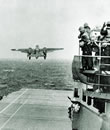 Soon known as the Doolittle Raid, the operation was small in the great scheme of the war, but because of its modest size, it’s relatively easy to follow every one of the 80 men involved, see where they sat in their 16 B-25 Mitchell bombers aimed for Tokyo and four other cities, and track to the present day where each raider ended up afterward. It was a crazy idea that many thought impossible to pull off, a suicide mission. But this first joint army-navy operation since the Civil War turned out to be quite a success, even though the bombing did little actual damage, and even though 14 percent of the force was captured or killed and all the airplanes lost. It was a success because the Japanese would never again be able to sit at home confident that America could not attack them there.
Soon known as the Doolittle Raid, the operation was small in the great scheme of the war, but because of its modest size, it’s relatively easy to follow every one of the 80 men involved, see where they sat in their 16 B-25 Mitchell bombers aimed for Tokyo and four other cities, and track to the present day where each raider ended up afterward. It was a crazy idea that many thought impossible to pull off, a suicide mission. But this first joint army-navy operation since the Civil War turned out to be quite a success, even though the bombing did little actual damage, and even though 14 percent of the force was captured or killed and all the airplanes lost. It was a success because the Japanese would never again be able to sit at home confident that America could not attack them there.
The Man
For these [fliers] to learn that their mission leader was none other than the world-famous and notorious Lt. Col. James Harold Doolittle —well, it would be like being asked to join a secret new baseball team, and it just so happens the lead guy’s Babe Ruth. —Craig Nelson in his book The First Heroes: The Extraordinary Story of the Doolittle Raid—America’s First World War II Victory (2002)
It would be impossible for Jimmy Doolittle to become the most famous pilot in a nation that also included Charles Lindbergh, but he tried. On September 4–5, 1922, Doolittle became the first man to fly across the United States in less than 24 hours. Nine years later he did it in less than 12. He was first to perform an outside loop and first to take off, fly, and land “blind,” using only instruments. By the time he retired in September 1947 after three decades in the air, he had flown more than 10,000 hours in 265 different types of aircraft. During the First World War, Doolittle had been a flight instructor in the Signal Corps and organized a military stunt-flying team called the Five Daring Acrobats, but although he was moved around the States to Texas, Ohio, Louisiana, and California, he never made it overseas. Between the wars, he worked for Shell Oil and helped develop the first high-octane fuel. He won many of the major trophy races in this golden age of air racing. In 1925 he set the world seaplane speed record at 245 miles per hour and seven years later set the world land plane speed record at 296.
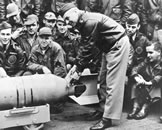 Doolittle returned to active duty in July 1940 and was working as a troubleshooter on the staff of Henry “Hap” Arnold, commanding general of the US Army Air Corps (which would be renamed the US Army Air Forces in July 1941), when the raid on Japan was first mentioned. Arnold knew Doolittle was the perfect man to command the mission, but he was also too valuable to lose. Arnold wanted him to train the men, get the planes ready, then stay behind. Doolittle, on the other hand, having missed out on combat in World War I, was not so easily dissuaded. Not only would he go along on the raid, the 45-year-old lieutenant colonel would sit in the pilot’s seat of the first B-25.
Doolittle returned to active duty in July 1940 and was working as a troubleshooter on the staff of Henry “Hap” Arnold, commanding general of the US Army Air Corps (which would be renamed the US Army Air Forces in July 1941), when the raid on Japan was first mentioned. Arnold knew Doolittle was the perfect man to command the mission, but he was also too valuable to lose. Arnold wanted him to train the men, get the planes ready, then stay behind. Doolittle, on the other hand, having missed out on combat in World War I, was not so easily dissuaded. Not only would he go along on the raid, the 45-year-old lieutenant colonel would sit in the pilot’s seat of the first B-25.
The Plan
The purpose of this special project is to bomb and fire the industrial centers of Japan. [T]his will not only cause confusion and impeded production but will undoubtedly facilitate operations against Japan in other theaters [when they withdraw] troops for the purpose of defending the home country. —memo from Doolittle to Hap Arnold in the first week of February 1942
As you embark on your expedition please give each member of your command my deep appreciation of their services and complete confidence in their ability and cour-age under your leadership to strike a mighty blow. —radiogram sent to Doolittle by army Chief of Staff George Marshall on March 31, 1942
In early 1942, America was ready to strike back, but not sure how. The type of aircraft used on carriers at that time could hit targets only within 300 miles, and nobody wanted to take the remains of the Pacific Fleet that close to Japan. The largest bomber force in the region had been the 35 B-17s in the Philippines, but many of those planes had been destroyed a few hours after Pearl Harbor, in another surprise attack. Plus, the B-17s had a round-trip range of less than 1,000 miles, and Japan was 2,000 miles away. Russia was within striking distance of Tokyo, but Stalin didn’t welcome American planes on Soviet soil because he didn’t want Japan angry at him while he was already struggling with Hitler to the west. Portions of China lay within striking distance of Japan, but Japan already occupied those.
During a discussion of the invasion of North Africa on January 4, Admiral Ernest King, chief of naval operations, suggested that aircraft carriers be used to transport a large quantity of army fighter planes. Arnold took the idea further. “We will have to try bomber take-offs from carriers,” he wrote in a memo sent that night to his staff. “It has never been done before but we must try [it] out….”
About a week later, Captain Francis Low, a submarine officer on King’s staff, asked to meet with his boss. While in Norfolk, Virginia, earlier that day to check on the progress of the navy’s newest aircraft carrier, the Hornet, Low had had an idea. Waiting for his plane to take off and return to Washington, Low had been idly looking out the window when he noticed the outline of an aircraft carrier painted on the air strip. Naval pilots commonly used such lines to practice takeoffs and landings without any danger of landing in the water, but as Low watched, two army bombers happened to fly over the outline. “If the Army has some planes with longer range than our carrier planes, and they could take off in the length of a carrier deck,” he told King, “it seems to me a few of them could be loaded on a carrier and used to bomb Japan.”
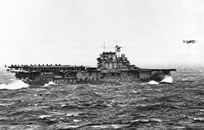 The army bombers, it turned out, could never land on a carrier. They came in very fast for so short a landing strip, and their tails were too weak to take the shock of such a sudden landing—and too high off the ground for landing hooks to be attached to them. It did seem possible, though, for bombers to take off from a carrier. Could crews carry out their missions, then fly back to a carrier, ditch their planes in the sea beside it, and get hauled aboard? That seemed a waste of airplanes. Could the planes bomb Tokyo, and then continue on to land in Russia? Stalin said no. Or China? Chiang Kai-shek said maybe. All of the options seemed like long shots, but this last plan seemed plausible. Since the Hornet was scheduled to come around to the West Coast anyway, it became the official carrier of the Doolittle Raid.
The army bombers, it turned out, could never land on a carrier. They came in very fast for so short a landing strip, and their tails were too weak to take the shock of such a sudden landing—and too high off the ground for landing hooks to be attached to them. It did seem possible, though, for bombers to take off from a carrier. Could crews carry out their missions, then fly back to a carrier, ditch their planes in the sea beside it, and get hauled aboard? That seemed a waste of airplanes. Could the planes bomb Tokyo, and then continue on to land in Russia? Stalin said no. Or China? Chiang Kai-shek said maybe. All of the options seemed like long shots, but this last plan seemed plausible. Since the Hornet was scheduled to come around to the West Coast anyway, it became the official carrier of the Doolittle Raid.
The Plane
After we chatted a while they asked me if I had flown a B-25 before. I had to be honest. I had never even seen a B-25 before. —US Navy Lieutenant Henry Miller, who taught the Doolittle raiders how to take off from a carrier
Two medium bombers were considered first for the mission: the B-23 Dragon and the B-26 Marauder. But the B-23, an improved version of the B-18 Bolo, wouldn’t fit on an aircraft carrier due to its 92-foot wingspan. And the B-26 wouldn’t be able to get into the air before it ran out of room on the Hornet’s flight deck.
That left the twin-engine B-25 “Billy” Mitchell medium bomber, one of the few US military aircraft named for a specific person. The B-25s might make it to Japan and away safely, but first they needed many modifications. Most important were three additional gas tanks, which almost doubled the plane’s capacity to 1,141 gallons. (An additional 50 gallons, in five-gallon cans, was stored at the rear of the plane.) One fuel tank replaced the gun turret under the B-25. The rear .50-caliber guns also were replaced, by two wooden broomsticks painted black. The 230-pound radios were removed; they couldn’t be used during the mission anyway. So were the top-secret Norden bombsights. No one wanted these to fall into enemy hands, and they were more effective at high altitude, anyway. The raiders, bombing from 1,500 feet, would use a sight nicknamed the “Mark Twain,” designed by pilot Charles Greening of plane 11. Manufactured on the spot from two pieces of aluminum, it cost about 20 cents.
The 17th Bombardment Wing, which had been flying anti-submarine patrols off the US West Coast while based at Pendleton Field in Oregon, provided 24 B-25s and their crews for the raid. The army pilots were used to taking off along 1,000 feet of runway at more than 100 miles an hour. When Henry Miller, their naval flight instructor, told them they had to do it in less than half that distance, at half that speed, they thought it impossible. At first, hardly any of them were able to take off in less than 800 feet, but then their distances started to drop. Pilot Don Smith of plane 15 ended up with the group record, getting off the ground after only 287 feet.
Time was extremely limited; by May, turbulent seasonal wea-ther patterns in the North Pacific would make the mission impossible. Pilot Ted Lawson of plane 7 wrote in his personal account of the raid, Thirty Seconds over Tokyo (1943), that “every minute counted.” He even told his engineer-gunner David Thatcher “to stop calling me ‘sir’ because it was a waste of time.”
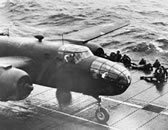 For the first three weeks of March, the crews worked at Eglin Field in western Florida, then 22 of the planes flew cross-country to Sacramento. On March 31 and April 1, 16 of the Mitchells (all that would fit) were loaded onto the Hornet at nearby Alameda Naval Air Station. A day later the carrier, accompanied by four destroyers, two cruisers, and an oiler, passed under the Golden Gate Bridge and headed out to sea. They would join forces 11 days later with an identical group of eight ships sailing from Pearl Harbor, led by the carrier Enterprise, the flagship of Vice Admiral William “Bull” Halsey’s Task Force 8.
For the first three weeks of March, the crews worked at Eglin Field in western Florida, then 22 of the planes flew cross-country to Sacramento. On March 31 and April 1, 16 of the Mitchells (all that would fit) were loaded onto the Hornet at nearby Alameda Naval Air Station. A day later the carrier, accompanied by four destroyers, two cruisers, and an oiler, passed under the Golden Gate Bridge and headed out to sea. They would join forces 11 days later with an identical group of eight ships sailing from Pearl Harbor, led by the carrier Enterprise, the flagship of Vice Admiral William “Bull” Halsey’s Task Force 8.
The Target
When Doolittle revealed what the mission was, I was scared, but also impressed and fascinated by the audacity of this plan. Not volunteering was as unthinkable as not stepping over the line at the Alamo. —a Doolittle raider from Texas interviewed for The First Heroes
Heigh-ho, heigh-ho, we’re off to Tokyo. We’ll bomb and blast and come back fast, heigh-ho, heigh-ho. —a ditty the raiders sang on the Hornet after they were finally told the details of their mission
For want of a nail, the shoe was lost. That’s the way it goes in war—the little things will kill you. For the Doolittle raiders the little thing turned out to be the Nitto Maru, a Japanese fishing boat on picket duty. US intelligence didn’t know about the ring of sentry boats anchored 650 miles off Japan’s shores. By the time the Hornet’s lookouts noticed the Nitto Maru 10,000 yards away across a rainy, cloudy sea, there was little chance the Japanese lookouts hadn’t spotted the 809-foot-long, 20,000-ton aircraft carrier.
The cruiser Nashville sank the boat, but the discovery of the task force meant the B-25s had to leave immediately, 150 miles short of their planned takeoff point. To linger invited a Japanese attack, which would endanger essentially all that was left of the US Pacific Fleet. Doolittle took off at 8:20 a.m., and the other 15 B-25s followed over the next hour, mostly at three- to four-minute intervals. Each plane gained altitude, then circled and flew low over the carrier’s flight deck, using it as a compass in heading for Japan.
The last plane, nicknamed Bat Out of Hell, did have a hellish time getting aloft. Positioned so far to the rear that its tail hung over the stern, plane 16 was rocked by prop wash (vigorous backward air movement caused by propellers) from the takeoff of plane 15. When sailors ran to tie ropes to it to keep it from sliding backwards into the sea, one slipped and fell into a propeller, which sliced his arm so severely it had to be amputated. Somehow, a 12-inch hole also had appeared in the plane’s Plexiglas nose, which would slow it down and use up more fuel, but there was no time for repairs. “With one exception,” wrote Captain Marc Mitscher of the Hornet, “takeoffs were dangerous and improperly executed.” But the men just wanted to get into the air, and they all did.
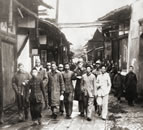 The 16 planes, unable to communicate with one other, headed for Japan in a staggered line 50 miles wide and 150 miles long. The first 10 were aimed at Tokyo, and they arrived beginning just after noon, when by coincidence the city was finishing up an air raid drill. Many Japanese waved at the planes, perhaps because the Army Air Forces insignia in those days included a red circle in the center, like the Japanese flag. The other six planes attacked targets in Yokohama, Kobe, and Nagoya and on the Yokosuka Naval Base. Enemy planes were ineffective against them. Several even seemed to be scared off by the painted broomsticks in the rear. Anti-aircraft fire was intense but inaccurate, and only plane 10 was hit at all, leaving it with a small hole in its fuselage.
The 16 planes, unable to communicate with one other, headed for Japan in a staggered line 50 miles wide and 150 miles long. The first 10 were aimed at Tokyo, and they arrived beginning just after noon, when by coincidence the city was finishing up an air raid drill. Many Japanese waved at the planes, perhaps because the Army Air Forces insignia in those days included a red circle in the center, like the Japanese flag. The other six planes attacked targets in Yokohama, Kobe, and Nagoya and on the Yokosuka Naval Base. Enemy planes were ineffective against them. Several even seemed to be scared off by the painted broomsticks in the rear. Anti-aircraft fire was intense but inaccurate, and only plane 10 was hit at all, leaving it with a small hole in its fuselage.
All the B-25s except plane 4, which fled from a number of fighter planes because its guns became inoperative, dropped their four 500-pound bombs accurately on targets. Two of each plane’s bombs were demolition bombs, and the other two contained clusters of 128 incendiary bombs each. All four bombs on Doolittle’s plane were incendiaries, because the original plan had been for him to reach Tokyo three hours ahead of the other fliers and start fires to guide them in during what was to have been a nighttime raid.
After leaving their bombs behind, all 16 B-25s left Japan as quickly as possible. American bombers would not return to Japan for more than two years.
The Aftermath
…the fact that the raid was attempted proves most conclusively in what pitifully desperate condition the United States now finds herself.… —the Japan Times and Advertiser, April 22, 1942
…no raid is a success in which losses exceed 10 percent and it now appears that probably all of the airplanes were lost. —Hap Arnold in a memorandum to President Franklin Roosevelt dated April 23, 1942
My cap is off to Jimmy and his brave squadron…. Their flight was one of the most courageous deeds in all military history. —Admiral William “Bull” Halsey
The B-25s were desperately short of fuel as they left Japan, but then an unexpected 25- to 30-mph tailwind added several hundred miles to their range. This enabled them to reach (in a few cases almost reach) the coast of China, but it was part of a storm front that made landing impossible.
Due to the raid’s extreme secrecy, plus the usual confusions of long-distance wartime operations, no real preparations had been made to receive the planes in China. “In the end,” writes Craig Nelson, “the airfields were never arranged, inspected, or supplied as planned, and the boys, already flying on a prayer, would find that some prayers go unanswered.”
Planners in Washington, DC, also had made a ridiculous blunder, forgetting that the ships would lose a day (April 14) crossing the International Date Line, putting the planes in China a day earlier than anyone expected. Because of this mix-up, when some of the bombers flew over Chuchow Field, which was supposed to have been their main refueling base, an air raid alarm sounded and the lights turned out.
Ultimately, 11 of the crews had to bail out and sacrifice their planes. As navigator Thomas Griffin of plane 9 said, “The bottom hatch was opened and one by one we eased down through the black hole into nothing. Jumping at night and in a storm is an experience one will never forget.” Only Doolittle had ever parachuted before (twice), but with a few exceptions—a broken shoulder, foot, or kneecap, and sprained ankles—all but one of the others reached the ground safely. Leland Faktor, engineer-gunner of plane 3, was killed in the fall.
Four of the other B-25s crash-landed, three in the water and one in a rice paddy. Crew members from planes 2 and 5 emerged safely, but William Dieter and Donald Fitzmaurice, the two enlisted men on plane 6, drowned just off the China coast. Four of the five crewmembers of plane 7 were hurt seriously, and pilot Lawson’s leg had to be amputated in the field by Thomas “Doc” White, plane 15’s gunner, who had graduated from Harvard Medical School.
Plane 8, low on fuel its entire trip, made its way to near Vladivostok, Russia, instead of China. The crew members landed safely, but were interned by the Soviets for more than a year before they escaped over the mountains into Iran in late May 1943.
Eight raiders, the surviving crew members of planes 6 and 16, were soon captured by the Japanese. Three were executed in October 1942 following a sham trial, one died of malnutrition in prison, and the other four continued to live under horrifying conditions—torture, disease, solitary confinement—until they were rescued in August 1945. (One of these last four—plane 16’s bombardier, Jacob DeShazer—would return to Japan after the war and spend 30 years there as a Christian missionary. Born in November 1912, he is the oldest surviving raider.)
With the help of locals in China, most of the raiders on the ground made their way to safety and were soon back in action. The city of Chungking had been bombed by the Japanese more than 100 times in the preceding decade, and the Chinese were delighted someone had returned the favor to Tokyo. But the Japanese wanted revenge for the revenge, and went berserk trying to strike back at everyone who might have assisted the raiders. They slaughtered as many as 250,000 people. “We heard stories far too brutal and savage to relate,” two Catholic priests told the New York Times in May 1943. “Just one charge was not heard—cannibalism.”
In all, 10 raiders died during World War II. Four escaped the Japanese only to end up in German prisoner-of-war camps. Today, 65 years after that clear April day over Japan, 15 of the 80 survive. They range in age from 84 to 93 years old. They are a true band of brothers, still meeting annually to talk over old times and celebrate their remarkable achievement.
Two days after the raid, Doolittle stood next to his wrecked B-25 on a hillside in China. He had no idea what had happened to his other 75 raiders. The attack was “a complete failure,” he told Paul Leonard, his engineer-gunner, adding that the air forces “will never give me another plane.” He thought he would be demoted and possibly even court-martialed and sent to prison. Leonard disagreed. “When you return home,” he said, “they’re going to make you a general. And then they’re going to give you the Congres-sional Medal of Honor.” That’s exactly what happened.
Copyright 310 Publishing, LLC. All rights reserved.


FOLLOW US »
